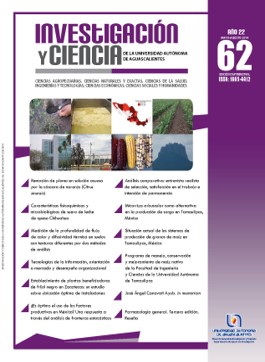Lead removal in aqueous solution using orange peel (Citrus sinensis)
DOI:
https://doi.org/10.33064/iycuaa2014623619Keywords:
sites chelating, adsorbent materials, heavy metals, demethylationAbstract
There are problems associated with toxicity and accumulation of heavy metals discharged into natural water bodies in the state of Chihuahua. Thus, Biosorption is a low-cost technology that can be applied to remove soluble ions. In this study the removal efficiency (RE) of Pb +2 soluble was assessed, using des-methylated orange peel. As reference process (T1), the orange peel was washed, dried, and milled. Orange peel portions from T1 were washed with 2M NaOH to pH 10, to obtain the demethylated
process (T2). The removal efficiency was evaluated in solutions at pH 3.0, to lead concentrations from 0.3 to 0.8 ppm and to mixing times of 1 h, 3 h and 6 h. Remaining Pb+2 was measured by atomic absorption. T2 showed the highest RE value (85.8 ± 3.9%) to 0.38
ppm.
Downloads
References
• AGUILAR GONZÁLEZ, M. A. et al. Remoción de plomo en soluciones acuosas por titanato de potasio dopado con silice. Revista Internacional de Contaminación Ambiental, 25(3): 125-132. Enero, 2009.
• ASHEN, H. et al. Remover of copper from aqueous solution using orange peel sawdust and bagasse. Pakistan Journal of Analytical and Environmental Chemistry, 8(1): 21-25, April 2007.
• ASMA, S. et al. Removal and recovery of heavy metals from aqueous solution using papaya wood as a new biosorbent. Separation and Purification Technology, 45: 25-31, September 2005.
• BHATNAGAR, A. y SILLANPAA, M. Utilization of agro-industrial and municipal waste materials as potential adsorbents for water treatment-A review. Chemical Engineering Journal, 157: 277-296, March 2010.
• BORCH, T. R. et al. Biogeochemical redox processes and their impact on contaminant dynamics. Environmental Science & Technology, 44: 15-23, November 13, 2010.
• DAVYDOVA, S. Heavy metals as toxicants in big cities. Microchemical Journal, 79: 133-136, January 2005.
• DOUMETT, S. et al. Heavy metal distribution between contaminated soil and Paulownia tomentosa, in a pilotscale assisted hytoremediation study: Influence of different complexing agents. Chemosphere, 72:1481-1490, April 29, 2008.
• DU- LAING, G. et al. Factors affecting metal mobility and bioavailability in the superficial intertidal sediment layer of the Scheldt estuary Aquatic. Ecosystem Health & Management, 10(1): 33-40, April 2007.
• EGGS, N. et al. Adsorción de Cromo Hexavalente en la cáscara de arroz modificada químicamente. Avances en Ciencia e Ingeniería, 3(3): 141-151, julio-septiembre 2012.
• GADD, J. M. Transformation and mobilization of metals, metalloids, andradionuclides by microorganisms. In: Biophysico-Chemical Processes of Metals and Metalloids in Soil Environments Parte I, pp 53- 56. Hoboken, NY, USA: WileyJupac Series,1 John Wiley & Sons, 2008.
• GARCÍA, V. R. et al. Estudio de la cinética de biosorción de iones plomo en pectina reticulada proveniente de cáscaras de cítricos. Revista de la Sociedad de Química del Perú, 77: 173-181, enero 11, 2011.
• HESTEKIN, J. A. et al. Poly(aminoacid)-functionalized cellulosic membranes: Metal sorption mechanisms and results. Industrial & Engineering Chemistry Research, 40: 2668-2678, May 8, 2001.
• MBHELE, P. P. Remediation of soil and water contaminated by heavy metals and hydrocarbons using silica encapsulation. Tesis University of the Witwatersand, 270 pp., 2007.
• NAVARRO, A. E. et al. Elucidación del efecto del pH en la adsorción de metales pesados mediante bío-polímeros naturales, cationes divalentes y superficies activas. Revista Iberoamericana de Polímeros, 7(2): 113-126, marzo 2006.
• PACHECO, T. J. et al. Cinética de la bioadsorción de iones cadmio (II) y plomo (II) de soluciones acuosas por biomasa residual de café (Coffea arabica L.). Revista de la Sociedad Química del Perú, 76(3): julio/diciembre 2010.
• PINZÓN-BEDOYA, M. L. y CARDONA, A. M. Caracterización de la cáscara de naranja para uso como material bioadsorbente. Bistua: Revista de la Facultad de Ciencias Básicas, 6(1): 1-23, mayo 2008.
• PUGA, S. et al. Contaminación por metales pesados en suelo provocada por la industria minera. Ecología Aplicada, 5: 49-155, diciembre 2006.
• RODRÍGUEZ, R. A. et al. Distribución química de plomo, cromo y cadmio en lodos cloacales y sus cenizas. Ingeniería, 11(2): 31-38, julio 12, 2007.
• SCHIEWER, M., y SANTOSH, B. Modeling the effect of pH on biosorption of heavy metals by citrus peels. Journal Hazardous Materials, 157: 8-17, July 2007.
• SRINIVASA, G. y GOVIL, P. K. Distribution of heavy metals in surface water of Ranipet industrial area in Tamil Nadu, India. Environmental Monitoring and Assessment, 136: 197-207, January 2008.
• TAPIA, H. N. et al. Biosorción de Pb (ll) por cáscara de naranja, Citrus cinesis, modificada. Revista Peruana de. Química e Ingienería Química,5(2): 48-53, septiembre 2003.
• TESKOVA, K. et al. Biosorption of Cooper (II) and Cadmium (II) from aqueous solutions by free and immobilized biomass of Aspergillumsniger. Bioresource Technology, 101: 1727-1731, October 2010.
• VIOLANTE, A. et al. Mobility and bioavailability of heavy metals and metalloids in soil environments. Journal of Soil Science and Plant Nutrition,10(3): 268–292, July 2010.
• ZHEXIAN, X. et al. Study on the equilibrium, kinetics and isotherm of biosorption of lead ions onto pretreated chemically modified orange peel. Biochemical Engineering Journal, 31(2): 160-164, July 2006.
De páginas electrónicas
• NOM-001-ECOL-1996. Límites máximos permisibles de contaminantes en las descargas de aguas residuales en aguas y bienes nacionales. De: http://enviro.lclark.edu:8002/rid, 20 mar. 2012.
Downloads
Published
How to Cite
License
Copyright (c) 2014 Marusia Rentería Villalobos, Leonela Ramírez Marfil, Nelson Aguilar Palma, Héctor Rubio Arias, Carmelo Pinedo Álvarez, Cristina Vélez Sánchez Verín

This work is licensed under a Creative Commons Attribution-NonCommercial-ShareAlike 4.0 International License.
Las obras publicadas en versión electrónica de la revista están bajo la licencia Creative Commons Atribución-NoComercial-CompartirIgual 4.0 Internacional (CC BY-NC-SA 4.0)









